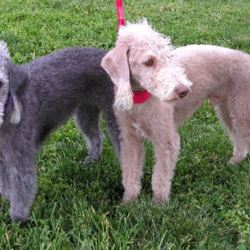To reduce swab testing for COVID, the ultimate goal is to have dogs able to perform rapid, large-scale, non-invasive screening, with antigen testing necessary only for confirmation after positive dog screening results.

Dogs can sniff out all sorts of things, as every dog owner knows. At the dog park, Cracker, my Bedlington Terrier, unfailingly finds all the dog owners who have treats in their pockets. I was privy to a more, uh, interesting illustration of canine olfactory skill some years ago…
When I fly back to the U.S. after a trip abroad, I’m always so eager to get back to Cracker that I can’t resist scratching and petting the USDA beagles at U.S. Customs, in spite of the “DO NOT PET” message on their vest. The handler is invariably annoyed and admonishes me. Well, one time, the dog got her scratch, then moved to my backpack and sat down – the signal for the detection of contraband. There was a long-forgotten banana at the bottom. That earned me an intensive inspection of all my luggage. (I do not recommend this.)
The ability of dogs to sniff out explosives, illicit drugs, and forbidden produce is well known, but there have also been some successes in getting them to detect various disease states. For example, diabetic-alert dogs are trained to sense certain volatile organic compounds (VOCs) that indicate high or low blood sugar in a diabetic’s breath or sweat. When the dog detects the characteristic odor emitted by the person, he (or she) alerts with a specifically trained behavior such as pawing, sitting, or barking.
There are numerous case reports of dogs spontaneously detecting and calling attention to human cancers, including skin and breast, and in various lab (no pun intended) experiments with human tissues and fluids, dogs have been trained to detect a wide array of cancers. They have also had modest success detecting malaria infections (caused by a parasite) in humans.
A fascinating ongoing project is a California-based pilot program to train dogs to detect COVID-19 infections in humans. After two months of training on COVID-19 scent samples in the laboratory, the dogs achieved greater than 95 percent sensitivity (the test’s ability to correctly designate a positive) and specificity (its ability to correctly call a negative) for detection of the virus. The dogs’ performance in real-world conditions was then tested in the field: 50 visits were conducted at 27 schools from April 1 to May 25, 2022, on 1,558 participants.
The screenings were performed on days when antigen testing was scheduled. The children stood six feet apart with their backs to two yellow Labradors – Rizzo and Scarlet — led by handlers. One by one, the dogs sniffed each student’s ankles and feet. To indicate a “COVID-positive,” a dog would sit down before moving on to the next person, similar to how the USDA dog signaled finding my illicit banana.
The investigators assessed the dogs’ sensitivity and specificity for COVID-19 infection, using antigen test results as the comparator. If a dog signaled positive and the antigen testing results were negative, the signal was considered a false positive; conversely, if a dog did not signal and the antigen testing results were positive, that was counted as a false negative.
The dogs did very well. In the field studies, their sensitivity of detection was 83 percent, with specificity of 90 percent.
The study's results were similar to those reported by German researchers last year. Eight trained dogs were expossed to sweat samples from 2,802 concertgoers at four events in Germany. Every subject underwent SARS-CoV-2 antigen and polymerase chain reaction (PCR) testing at the concert, but the investigators, dog handlers, and dogs were blinded to those results. The dogs turned up only two false-positive results and a single false-negative result. Sensitivity was 82% and specificity nearly 100%.
The ultimate goal is to have dogs able to perform large-scale, non-invasive COVID screening in real-world situations, with antigen testing necessary only for confirmation on persons with positive dog screening results. That approach would reduce significantly the number of antigen tests performed.
Sounds good to me. I’ll bite.
A postscript: With COVID testing in schools now infrequent, Rizzo and Scarlet have turned their noses to detect COVID in California nursing homes.
Note: An earlier version of this article appeared in Inside Sources.
